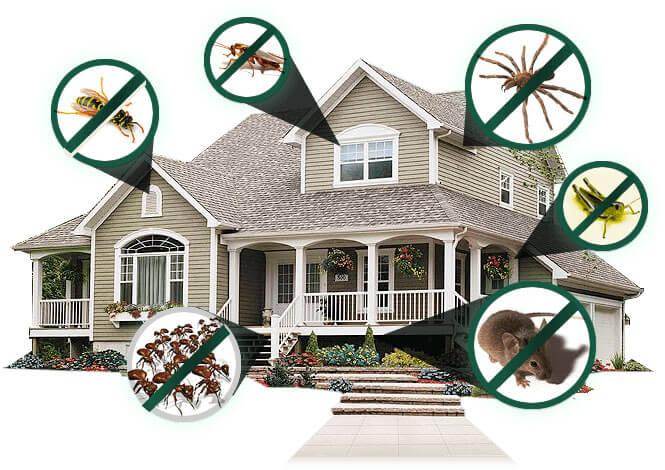A1 Commercial Pest Control Portland - Efficient Bed Bug Solutions for Organizations
A1 Commercial Pest Control Portland - Efficient Bed Bug Solutions for Organizations
Blog Article
Effective Bug Control Services: A Comprehensive Consider Extermination Techniques and Avoidance Actions
In the realm of bug control services, the effective administration of problems requires a careful method that integrates numerous strategies and steps for both removal and avoidance. From Integrated Parasite Monitoring (IPM) approaches that prioritize sustainable services to chemical elimination strategies created for targeted removal, the collection versus pests is huge and diverse. Organic control methods and physical prevention measures provide alternative courses to successfully combating undesirable intruders. Nevertheless, the key to a detailed parasite control plan exists not simply in the methods themselves, but additionally in the precise specialist inspection procedures that precede and educate them. By understanding the ins and outs of each technique and how they interplay, one can genuinely understand the intricacy and performance of contemporary parasite control solutions.

Integrated Parasite Administration (IPM) Techniques
Integrated Pest Management (IPM) Approaches incorporate a thorough strategy to pest control that concentrates on avoidance, monitoring, and control methods to efficiently manage bug populaces. By integrating different techniques, IPM intends to decrease the effect of insects while also reducing the dependence on chemical pesticides. Avoidance lies at the core of IPM, highlighting practices like correct cleanliness, maintenance of health, and sealing entry points to deter parasites from infesting buildings.
Chemical Extermination Strategies
Chemical elimination methods are commonly used in insect control solutions to successfully eliminate bug populaces that pose a hazard to human health and wellness and home. These techniques include using numerous chemical substances especially developed to target and remove insects such as pests, rodents, and various other unwanted animals. The application of pesticides, pesticides, rodenticides, and various other chemical agents is carefully managed to ensure optimum efficiency while decreasing dangers to human beings, animals, and the environment.
One of the vital advantages of chemical elimination techniques is their capability to offer quick and targeted outcomes, making them specifically helpful in instances of serious problems or immediate pest control requirements - a1 pest control in portland oregon bed bugs. However, it is vital to emphasize the importance of appropriate handling, application, and disposal of these chemical items to stop unintentional damage
Moreover, incorporated parasite administration (IPM) techniques usually incorporate chemical elimination strategies with various other techniques such as hygiene, environment adjustment, and organic controls to produce a sustainable and extensive bug control method. By integrating chemical extermination methods deliberately within an IPM structure, bug control services can successfully handle insect populaces while decreasing possible threats to human health and wellness and the atmosphere.
Biological Pest Control Techniques
Using natural killers and parasites to manage bug populations is a lasting approach understood as biological parasite control. a1 bed bugs exterminator portland. One usual biological control approach involves presenting natural opponents of the target pest types, such Get More Info as ladybugs for aphid control or nematodes for termite infestations.
One more reliable biological control method is the use of microbial pesticides. These are normally happening microbes, such as microorganisms, fungis, and viruses, that particularly target and contaminate certain insect varieties. By utilizing these microbial agents, pest populations can be efficiently minimized without triggering or hurting helpful microorganisms damage to the setting.
Physical Insect Avoidance Actions
Applying physical insect prevention actions entails utilizing barriers and architectural alterations to discourage parasites from entering or infesting a building (a1 commercial pest control portland). One efficient approach is securing all potential entry points such as gaps around doors, home windows, and energy penetrations. Mounting door moves, screens on home windows, and securing fractures in the structure can help prevent bugs like insects and rats from getting inside. Additionally, keeping a clean and clutter-free environment is vital as insects are brought in to food sources and concealing spots. On a regular basis evaluating and repairing this link any damaged screens, vents, or roof floor tiles can likewise help in maintaining insects out.
Another physical prevention action is the usage of obstacles like secure fencing to maintain larger bugs such as raccoons or deer away from the building. By applying these physical bug avoidance steps, building proprietors can considerably decrease the risk of insect infestations and the damages they can cause.
Professional Insect Examination Treatments
Carrying out systematic and complete pest examinations is a basic element of professional insect management methods. Professional bug assessors are educated to diligently examine properties for indicators of infestations, recognizing pest species, access points, and conducive problems. The evaluation process commonly begins with an extensive assessment of both the interior and exterior of the facilities. This includes monitoring for bug droppings, nibble marks, nests, and any structural damages that may indicate insect task. Additionally, examiners might make use of customized tools such as wetness meters and borescopes to discover hidden infestations within walls or crawl areas.

Verdict
To conclude, efficient insect control services utilize a range of methods, consisting of Integrated Pest Monitoring strategies, chemical extermination approaches, organic controls, and physical prevention actions. Professional bug evaluation procedures play an important duty in determining and attending to pest concerns in a prompt manner. By implementing a combination of these methods, residential or commercial property proprietors can efficiently protect against and take care of pest infestations.
From Integrated Bug Administration (IPM) approaches that focus on sustainable options to chemical elimination strategies designed for targeted removal, the toolbox versus bugs is huge and multifaceted.Integrated Bug Management (IPM) Strategies encompass a comprehensive approach to pest control that concentrates on avoidance, control, and surveillance techniques to successfully handle parasite populaces.Chemical elimination strategies are generally used in pest control solutions to effectively eliminate parasite populaces that posture a threat to human wellness and residential property.Using all-natural killers and parasites to handle bug populations is a sustainable technique recognized as biological insect control.In conclusion, effective pest control services use a variety of methods, consisting of Integrated Parasite Administration approaches, chemical elimination approaches, organic controls, and physical prevention actions.
Report this page